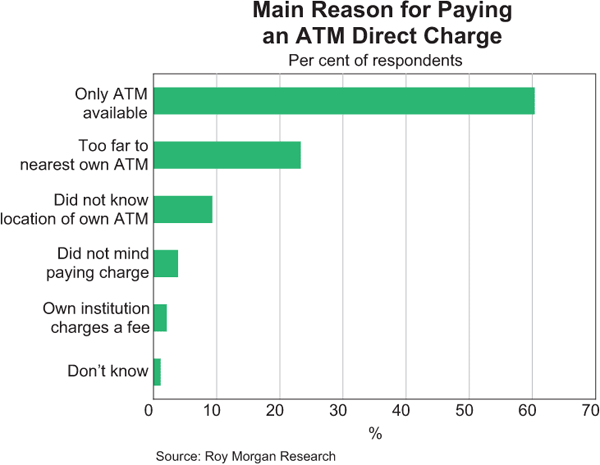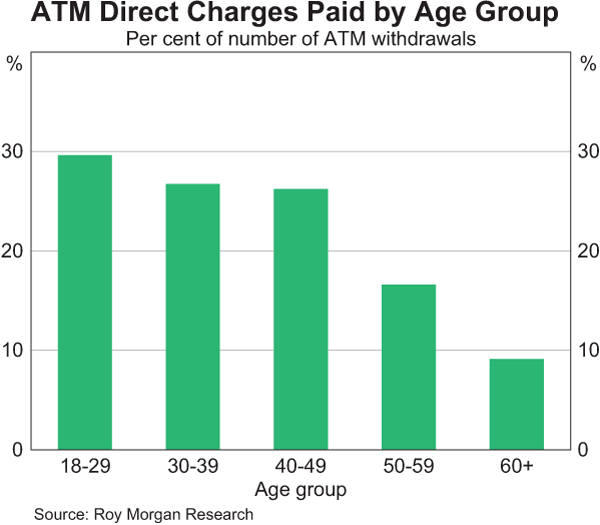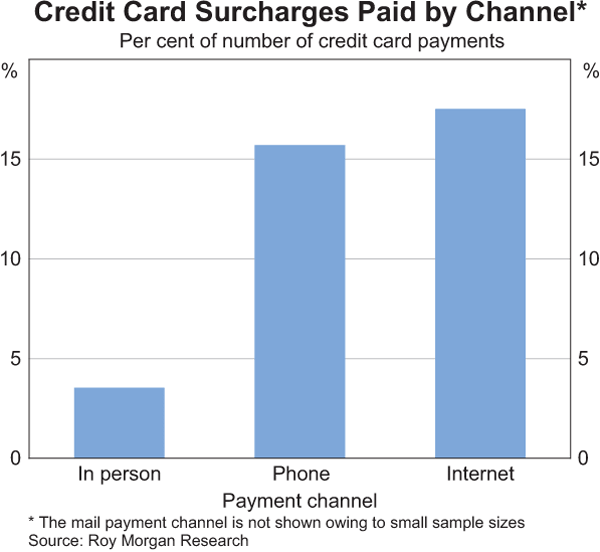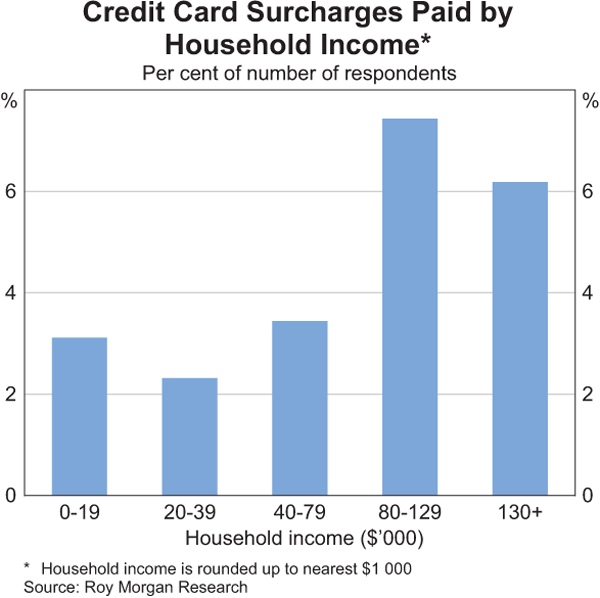Strategic Review of Innovation in the Payments System: Results of the Reserve Bank of Australia's 2010 Consumer Payments Use Study – June 2011 6. Insights into the Impact of Payment Systems Reforms
The Consumer Payments Use Study has provided an opportunity to gain new insights into consumers' responses to some of the reforms to retail payment systems that have occurred over recent years. In particular, the Payments System Board of the Reserve Bank has long considered that strong price signals to consumers about the relative costs of different payment methods are important for an efficient and competitive payments system. To that end, a number of reforms have been initiated to strengthen price signals to consumers. These include reforms to the charging of ATM fees, which increased their transparency and flexibility, and earlier reforms to remove rules which prevented merchants surcharging for credit and scheme debit cards. This section examines how these reforms have influenced consumer cash withdrawal and payment behaviour.
ATM Reforms
Consumers' cash withdrawal behaviour changed significantly following the ATM reforms that came into effect in March 2009. The main element of these reforms was the introduction of direct charging at ATMs, resulting in increased transparency and flexibility of ATM charges. As seen in other data previously reported by the Reserve Bank, consumers have reacted to the greater transparency by changing their behaviour to avoid ATM charges.[17] This is also evident in the changes in cash withdrawal behaviour observed between the 2007 and 2010 consumer use studies. One way in which individuals have sought to avoid fees is by making fewer ATM withdrawals. The average number of withdrawals from ATMs made by an individual in a one-week period decreased by 9 per cent between 2007 and 2010.
The diary data also support the previous finding that since the introduction of direct charging at ATMs, consumers have switched to cash withdrawal methods that do not incur a charge. For example, consumers made 24 per cent more eftpos cash-outs per week, on average, in 2010 than in 2007, although the average amount withdrawn per purchase was little changed.
Despite the significant changes in consumer behaviour, a reasonable proportion of consumers continue to pay an ATM direct charge. Around 23 per cent of ATM withdrawals made by respondents during the one-week diary study attracted a direct charge and around 50 per cent of respondents indicated that they had knowingly paid an ATM direct charge in the month prior to the study. The most common reason these respondents gave for paying a direct charge was that the ATM was the only one available (60 per cent, Graph 28). The next most common responses were that it was too far to the nearest fee-free ATM (23 per cent) and that the individual did not know the location of their nearest fee-free ATM (9 per cent).

Age is also an important determinant of whether a consumer pays a direct charge, with younger people more likely to pay direct charges than older people (Graph 29). This is likely to reflect a variety of factors, such as different preferences regarding the use of their time and the locations of their cash withdrawals, with older people possibly more likely to withdraw cash from a particular (direct charge-free) ATM as part of a regular spending pattern. Alternatively, this may indicate greater price sensitivity on the part of the elderly.

Credit Card Surcharging
In 2003, the Reserve Bank introduced reforms that removed restrictions on merchants imposed by the international card schemes, including restrictions that had prevented merchants from surcharging for credit card payments. As discussed in Section 4, the prevalence of merchants that surcharge at least one type of credit card has increased significantly over the past few years. However, the proportion of transactions on which a surcharge is paid remained largely steady over the same period, suggesting that consumers have become more sensitive to surcharges or better at avoiding them.
The end-of-study questionnaire provides insight into the influence of surcharging on consumers' choice of payment method. Participants were asked to indicate their typical behaviour when presented with a hypothetical situation in which they faced a 1 per cent surcharge for using a MasterCard or Visa credit card in a department store.[18] Only 36 per cent of consumers indicated they would choose to continue using their MasterCard/Visa credit card. A little under half of consumers would pay with a debit card or cash – payment methods that typically do not incur a surcharge – while 14 per cent of consumers would choose to go to another store (Graph 30).[19]

Respondents who reported holding an American Express or Diners Club card were also presented with another hypothetical situation where they faced a 2 per cent surcharge for using an American Express or Diners Club card, and a 1 per cent surcharge for using a MasterCard or Visa credit card.[20] This question was intended to examine consumer responses to ‘differential’ surcharging across card schemes. The majority of consumers would switch to using a MasterCard or Visa credit card (43 per cent – broadly similar to the proportion that would continue to use their MasterCard or Visa credit card in the first scenario), while 11 per cent would proceed with an American Express or Diners Club card (Graph 31). This result reflects the high degree of substitutability between American Express/Diners Club credit cards and MasterCard/Visa credit cards for those consumers that hold both cards, as well as the sensitivity of consumers to the higher surcharges that American Express/Diners Club cards typically attract. Of the remaining consumers, around 30 per cent would use a payment method that does not attract a surcharge, while around 10 per cent would go to another store.

While these scenarios reflect the behaviour of consumers in stores, consumers have less ability to use alternative payment methods when faced with a surcharge for remote payments. Not surprisingly, the proportion of transactions on which a surcharge is paid is significantly higher for payments made over the internet (18 per cent) and via phone (16 per cent), than in person (4 per cent, Graph 32).

Household income is another factor in paying a surcharge, with people from higher income households more likely to pay a surcharge on their credit card transactions (Graph 33). However, no evidence could be found that consumers who have a credit card with a rewards scheme are more willing to pay credit card surcharges. This is consistent with the lack of importance placed by consumers on credit card rewards when choosing between payment methods at the point of sale.

Footnotes
See, for example, Filipovski and Flood (2010), and Flood, Hancock and Smith (2011). [17]
Only individuals who owned a MasterCard or Visa credit card were required to respond to this question. [18]
In a similar questionnaire on debit card surcharging in the Netherlands, only 5 per cent of consumers indicated they would go to a different store (Bolt, Jonker and Van Renselaar 2010). The application of surcharges is quite different in the Netherlands though, with consumers only being charged for low-value debit card transactions. Our results may also reflect not just consumers who would actually walk out of a store but also consumers who would avoid a particular store that they knew to surcharge. [19]
Only 10 per cent of consumers in the 2010 Study reported holding an American Express or Diners Club credit card. [20]